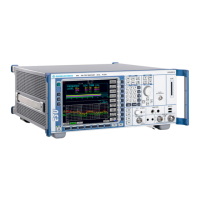R&S ESU Instrument Functions
Analyzer Mode
4.212 Operating Manual 1302.6163.12 - 03
Fig. 4.14 Intermodulation products P
U1
and P
U2
The intermodulation product at f
I2
is generated by mixing the 2nd harmonic of useful
signal P
U2
and signal P
U1
, the intermodulation product at f
I1
by mixing the 2nd har-
monic of useful signal P
U1
and signal P
U2
.
f
I1
= 2 × f
U1
- f
U2
(37)
f
I2
= 2 × f
U2
- f
U1
(38)
The level of the intermodulation products depends on the level of the useful signals.
If the two useful signals are increased by 1 dB, the level of the intermodulation prod-
ucts increases by 3 dB, which means that spacing a
D3
between intermodulation sig-
nals and useful signals is reduced by 2 dB. This is illustrated in Fig. 4.15
Dependence of intermodulation level on useful signal level.
Fig. 4.15 Dependence of intermodulation level on useful signal level
The useful signals at the two port output increase proportionally with the input level
as long as the two port is in the linear range. A level change of 1 dB at the input
causes a level change of 1 dB at the output. Beyond a certain input level, the two
port goes into compression and the output level stops increasing. The intermodula-
tion products of the third order increase three times as much as the useful signals.
f
U1
f
U2
f
I2
f
I1
f
∆
f
∆
f
∆
a
D3
P
U1
P
U2
P
I1
P
I2
Frequency
Level
Output
level
Intercept point
Intermodulation
product
Useful signal
Input level
Compression
1
1
1
3

